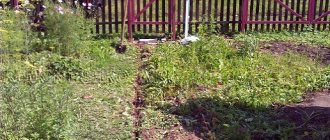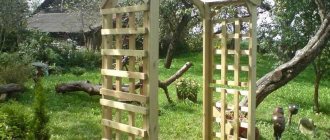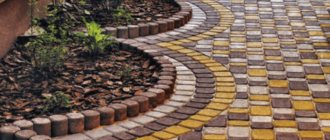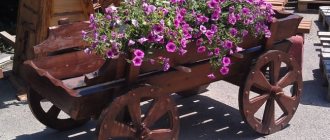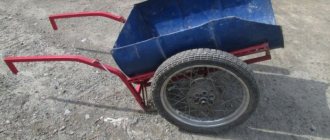The design stage is the key to success
The development of any suburban area involves planting greenery - fruit and ornamental trees, shrubs, flower beds. When arranging complex alpine slides, rock gardens and columbariums, we often forget about simpler landscape design solutions, such as comfortable, cozy alleys that require minimal maintenance.
Designing a suburban area involves marking all significant objects, including garden paths. As you can see, paths connect the house with the bathhouse and the veranda, and one of them leads to the exit. Any of the marked paths can be turned into an alley by selecting trees or shrubs that suit the style
The easiest way to plan an alley is at the design stage of the entire garden plot. However, if the project has already been implemented, and there is practically no free space left, we use a backup option: we turn one of the garden paths into an alley.
Thus, we will kill two birds with one stone: we will competently organize the planting of the necessary plants and preserve pedestrian or transport communications that are important for the dacha.
The question often arises: how to indicate green plantings on plans or diagrams? There are several ways - using pictures or symbols. For example, in this diagram, all plants are marked with green circles of different shades
To visualize the project visually, you can draw several sketches or draw a simple diagram.
Color combination
Of course, any variety is planted in the same type or combined with other species. This is just like a fantasy. But in any case it will be very beautiful. You can, for example, plant bushes of different shades alternately along the arch. And so several rows are planted. The transition of colors will look very impressive. Here are variations of the combination of roses with other flowers:
- Bezella white;
- Kobeya climbing;
- Nasturtium;
- Morning glory;
- Schisandra;
- Bryony.
And between the arches, if you wish, you can plant the following beautiful flowers:
- Peonies;
- Tulips;
- Echinacea;
- Chamomiles;
- Decorative sunflowers;
- Cannes;
- Callas;
- Hydrangeas;
- Hyacinths;
- Dicentra is magnificent;
- Lantanas;
- Dendrobiums.
Combine roses with those flowers that you like - the result will be very beautiful.
Garden Alley
1
( 17 ratings, average: 4.59 out of 5)
Back
Choosing a cultivator for your garden
MORE
Types of alleys - from pergola to main path
Even at the design stage, you should decide on the type of planting. Considering that suburban areas have different areas, topography, and style, let’s consider the features of the alleys, which differ in both length and design.
The purpose of all dacha objects plays an important role, therefore, based on functional features, two types of alleys are distinguished: main and secondary; the latter, in turn, are divided into access and walking. The main alleys are typical for palace and park landscapes, so it is inappropriate to consider them within the framework of a dacha theme, but driveway and pedestrian options are good for areas of any size, even the smallest 6 acres.
Suppose a small orchard, consisting of even 10 apple or cherry trees, can be arranged in the form of a short cozy alley from the gate to the house or from the house to the gazebo. With laconic pergolas it is even easier - they can be placed on any part of the garden path.
Fruit trees in large country gardens are usually planted in even rows. If the garden is already mature, you can use one row (for example, the central one) to create a beautiful flowering alley - just lay out a path convenient for walking
Complex structural combinations are more suitable for spacious areas, but in a country house the optimal solution is a simple alley consisting of two rows of plants on both sides of the path. The width depends on the purpose of use: the driveway for transport should be 2 times wider than the walking option, for which 1.5-2 meters is enough.
The order in which trees are planted along the edges of the path may also differ. There are two types of plant arrangement: symmetrical and checkerboard. The degree of illumination and visibility of the surrounding landscape depends on planting intervals. For example, the Russian estate landscape is characterized by a dense planting of trees and shrubs, forming real green fences along the edges of the path.
Sparsely spaced trees are not suitable for a limited area, while in a spacious area they will look appropriate without blocking the surrounding landscape.
If the size of the plot allows, and the gate is located on the side opposite from the house, you can create an extended park alley in a free style
If the width of the pedestrian (travelling) area allows, it is worth thinking about a two- or three-tier arrangement of plants. Large trees are used for the outer row, low-growing trees or lush shrubs for the middle row, and low shrubs, dense greenery or flowers for the inner row.
When choosing this or that type of alley in your dacha, pay attention to the stylistic nuances. For example, for a landscape in a Russian rustic style, spreading birch trees, cedar pines, dense thickets of rose hips or berry bushes - raspberries, currants, gooseberries - are suitable. Slender geometric shapes are good for a regular garden - pyramidal cypresses, larches, poplars.
The same principle applies to the shape of the alley itself. It does not have to be straight, connecting, like a string, two dacha objects. There are curved, winding, zigzag, arched alleys, as well as those located around a circle or along the perimeter of a summer cottage.
An absolutely dacha option, suitable for a plot of any size - a two-tier alley of sparsely planted, decoratively trimmed poplars and lush flower beds
Creating a shady, closed alley requires special skill: trees with dense foliage must be planted at intervals of no more than 3-4 meters, and dense thickets should be used for the lower tier.
Sometimes, creating a shaded corner requires the construction of frames, and the result is a magnificent arched berm or pergola with flat ceilings. They are less typical in the north, but in the southern regions they are saving islands in extreme heat. For the picturesque design of arched and rectangular ceilings, grapes, clematis, wood pliers, honeysuckle or fragrant climbing roses are ideal.
Such a unique mini-alley can be created by using several arches instead of trees and planting lushly flowering hanging plants: petunia, begonia, lobelia, viola, diascia, climbing roses
We are creating a pedestrian zone
In order for the alley to be convenient for movement in any weather, it is necessary to equip it with a comfortable and even surface that would remain relatively dry even in rainy weather.
The shapes of garden paths visually change the space of the site:
- If you make the paths straight and long, the area will visually become narrower.
- Thanks to the winding paths, the area will visually expand.
Paved paths that require a lot of time and labor, but are considered the most wear-resistant and impeccable in an aesthetic sense, will look ideal. For paving paths, it is advisable to use the following materials:
- paving stones,
- bricks,
- paving slabs,
- homemade concrete blocks,
- natural stone.
Using elements of different colors, craftsmen create beautiful ornaments, lay out geometric patterns, creating a wonderful combination of path coverage and blooming greenery.
Laying paving stones for a garden path.
Try to ensure that the material with which the garden paths are paved is combined with the objects located in the country house and is of the same style. For example, a path lined with gray and red paving stones will harmonize perfectly with green spaces, wrought-iron fences and brick supports.
When using wood, you should be careful, since walkways are not always appropriate for an alley - they can get wet from rain and become slippery. Those who prefer wood flooring should take an interest in garden parquet - decking, which was created specifically for use in suburban areas.
Natural and relaxed paths are built using sand, pebbles or gravel. They have another significant advantage - they have a minimal cost.
You can design the descent in an unusual way - lay it out with wooden steps. On both sides of the steps you can plant dense shrubs or tall and slender trees. The result will be a beautiful shady alley along which it will be pleasant to go down.
How to improve a garden path?
Suppose that our beloved, but too “bare” summer cottage plot does not have enough green space. You can plant trees around the perimeter, as most conservative summer residents do, but we will be smart and do something original - we will turn a boring, naturally trodden path into a picturesque and functional alley. Its functionality lies in the fact that we will plant not simple poplars and birches, but useful fruit plants - apple trees, pears and plums.
Stage #1 – drafting
The main thing in any planned event is the right start, and in our case, drawing up a project. It is not worth setting up an alley in any ill-conceived place, because in a few years the trees will grow and create a lot of problems: they will cover sunny areas with flower beds, violate the waterproofing of the pond with their roots, or divide the territory into inconvenient zones. It is necessary to choose a place that is comfortable both for plants and for owners of country lands.
When making preliminary calculations, carefully study the nuances of planting and growth of all trees. The depth of the hole, optimal planting intervals, average height - and, as a result, the appearance of the future alley - depend on their individual characteristics
Perhaps a path leading to a vegetable garden or bathhouse would be suitable for creating an alley - it would be nice to walk in the shade after working in the garden beds or a hot steam room. Another winning option is a path running to the gate. Guests who visit the dacha will be pleasantly surprised by the unusual organization of the original garden.
Recent Entries
Lilac perennials that are beautiful, compact and do not crowd out other plants Why when buying seedlings you should not take the sellers’ word for it and how to determine the age of the plant using 3 signs Tomato seedlings have turned purple or whitish: why the color has changed and how to save the plants
When choosing fruit or ornamental plants, do not forget to include in the project in advance the material for arranging a comfortable garden path, especially if it is used daily
Stage #2 – marking on the ground
Having drawn up a project, choosing plants and materials, you can begin land work. They will consist of two parts: construction of the path and planting of green spaces. But first, it is necessary to make markings so that both the plantings and the pedestrian zone occupy strictly designated places and look harmonious. The locations of the holes for seedlings can be marked with pegs, and the boundaries of the path can be marked with construction cord.
A park option suitable for a spacious suburban area. Along the edges of the alley, birch trees are planted - fairly tall and spreading trees that mainly serve an aesthetic purpose. Get ready that you will see a similar picture only 10 years later, when the trees grow
At this stage, you can bring the necessary materials - tiles, bricks, paving stones for the path. Perhaps it will just be sandy or pebbly, but even in this case, you should consider such nuances as a drain for rainwater or a low border.
Stage #3 – design of the pedestrian zone
To make it pleasant to move along the alley in any weather, you need to take care of a comfortable, smooth canvas that would keep you relatively dry even in rainy weather.
The ideal option is a paved surface - the most expensive and labor-intensive, but surprisingly wear-resistant and aesthetically impeccable. Paving stones, bricks, paving slabs, homemade concrete blocks, and natural stone are suitable for its design. From elements of different colors you can create beautiful geometric patterns and ornaments that will create an interesting combination with blooming greenery.
Make sure that the material of the paths is combined with the surrounding objects and does not go out of style. Suppose gray and red paving stones are in perfect harmony with both green spaces and a wrought-iron fence on brick supports
Wood must be used extremely carefully, since the walkways are not entirely appropriate for alleys, and in addition, when it rains, they get wet and become slippery. If you still like wood flooring, pay attention to garden parquet - decking, created specifically for suburban outdoor use.
Bulk paths made of sand, pebbles or gravel look natural and relaxed, and their cost is minimal.
An unusual design option for the descent, lined with wooden steps. You can beat it by planting identical green spaces on both sides - dense shrubs or tall slender trees to create a shady alley leading down
Stage #4 – planting trees and shrubs
Trees can be planted both before and after the construction of the path, focusing on a more successful, recommended planting period. If you have chosen fruit tree seedlings, pay special attention to their purchase: they must be healthy and equally developed. Choose a variety that grows well in your region and a rootstock type that contributes to drought tolerance.
Fruit plants for the alley are planted in the same order as for regular garden planting. The main thing is to observe the size of the holes and intervals that affect the light transmittance of trees
Apple, plum and pear trees can be planted in both spring and autumn, while cherries, peach and apricots take root much better when planted in early spring. All berry bushes tolerate spring planting well; in the fall they can freeze. Many ornamental plants, such as pyramidal poplar, are planted during one of the growing seasons, that is, in autumn or spring.
When planting fruit trees, do not forget that they require more attention than maples, birches and spruces, which do not need regular care.
Depending on the type of trees and their growing conditions, dig holes in a symmetrical or checkerboard pattern, plant the seedlings, remembering to fertilize them, and wait patiently for them to grow. Overgrown branches can be trimmed, forming slender figures, balls or spreading crowns.
We mark the area
After drawing up the project, choosing plants and materials, land work begins, which is divided into two parts:
- construction of a path,
- planting green spaces.
However, first, markings are made in order to equip the landing and pedestrian zone in strictly designated areas, and so that all this is located harmoniously. Mark the places where the holes for planting seedlings will be located using pegs, and draw a construction cord around the border of the roadway.
An excellent park option for spacious suburban areas would be to plant birch trees along the edges of the alley - tall and spreading trees that carry an aesthetic value.
This stage also includes the delivery of the necessary materials:
- tiles,
- bricks,
- paving stones for arranging the path.
The path can be sandy or pebble. In any case, it is necessary to think through the drains through which rainwater will flow, and it is also a good idea to equip it with a low curb.
How to make a pergola: brief instructions
An enfilade of pergolas entwined with hops, roses or grapes looks simply magical and is a kind of shady alley, ideal for small summer cottages. By installing a comfortable bench on the edge, you will also get a wonderful place to relax.
The size and shape of the pergola can be different, but calculate the height of the building so that a person can easily walk inside it without bending over.
From the bars we assemble a pair of buildings, reminiscent of horizontal bars, installed along the path opposite each other. First we dig in the pillars, then using metal corners we mount the upper crossbars. The top can be designed in different ways: in the form of gentle slopes or simply a perpendicular panel. If you have extensive experience in this matter, then playing will not only be fun, but also profitable. Online casinos for real money are required to have a license. Play and win Pin Up slot machines!
We decorate the sides of the pergola with a lattice assembled from thin planks. At the base of the pillars we install flower pots with climbing crops.
In about 2-3 years, the perennials will grow and cover the entire surface of the pergola with foliage and flowers, forming a cozy shady corner.
Light lattice buildings with climbing flowers do not “load” the area of the site, unlike heavier oak alleys or dense green fences, so they are good for miniature areas
Selection of plants
Roses with thin stems are best suited for an arched garden ; they wrap around the arch better. It is also better to take roses that do not reach three meters in shoots. When choosing a variety, consider flavor and flowering. It is worth noting that flowering can occur a couple of times per season. Avoid buying flowers with large thorns. Consider the list of the most exquisite roses:
- Super Excelsa - blooms twice a season, buds are bright pink;
- Blaze Superior - buds grow densely, rich red;
- Blue perennial is a sophisticated lilac rose;
- Yasmina - fragrant soft pink rose;
- New Dawn is a famous type of pastel pink roses;
- Golden Rain is a variety of fragrant, bright lemon-yellow rose with large buds;
- My Queen is a type of delicate rose, medium sized buds with pink petals;
- Lavinia - this rose has lush buds, is tolerant of changes in weather and temperature and has a bright pink tone;
- Coral Dawn - umbrella-shaped buds of coral-red color;
- Dortmurd - classic-looking scarlet-red buds with a whitish center.
Industrial Culture Route
(Route der Industriekultur) ••• The Ruhr region in North Rhine-Westphalia has long been the main center of the German coal and steel industries. Today, a 400-kilometer Route of Industrial Culture runs through this region. A special place on it is occupied by the former Zollverein mine, a UNESCO World Heritage Site.
More on the topic
Tourist routes in Germany
German Volcanic Route
(Deutsche Vulkanstraße) ••• This 280 kilometer tourist route runs from the Rhine to the volcanic mountains in the Eifel region. Most of it passes through the Lacher See National Geopark. This is the name of one of the local lakes of volcanic origin, formed about 13 thousand years ago during the eruption of the Lach supervolcano.
More on the topic
Tourist routes in Germany
Wisteria tunnel, Kawachi Fuji Garden, Japan
Enchanted Wisteria Tunnel is waiting for you in Kitakyushu
An enchanted garden with a tunnel framed by clusters of Chinese wisteria is located in the city of Kitakyushu in the Fukuoka Prefecture of Japan. You can get to Kitakyushu by plane from Tokyo, then by rented car along Route 62 to Kawachi Fuji Garden. Travel time from the city center is less than 30 minutes.
16 ways to unravel Japan
Porcelain roads
(Thüringer Porzellanstraße, Bayerische Porzellanstraße) ••• The history of German porcelain dates back to 1708 in the Saxon city of Meissen, where a secret recipe was discovered, previously known only to the Chinese. Soon such productions appeared in other regions. Now in Germany there are two porcelain routes - in Thuringia and Bavaria. This photograph was taken in Meissen in 1890.
More on the topic
Tourist routes in Germany
Fondamenta San Mauro, Burano Island, Venice, Italy
You will immediately make friends with the colorful island quarter of Venice, Burano.
According to legend, the houses on Burano began to be painted in bright colors so that fishermen could see them from afar, even in heavy fog, and drop anchor in time. Local residents still have to coordinate the colors of the houses on Fondamenta San Mauro street and those neighboring the city hall: you must first figure out whether your façade will fit into the palette of the street. Come to Burano and see for yourself: it has no equal in color!
15 fun things to do in Venice and the lagoon islands
Rhine romance route
(Route der Rheinromantik) ••• The next route runs along the Rhine from Cologne to Mainz. The most beautiful part is the 67-kilometer stretch between Koblenz and Bingen, whose monuments were included in the UNESCO World Heritage List in 2002. The photo shows the Pfalzgrafenstein customs castle.
More on the topic
Tourist routes in Germany
Haji Lane, Kampong Glam, Singapore
Apart from the Gardens by the Bay, the Merlion statue and the Singapore Flyer, the must-see spot in Singapore is the bohemian Haji Lane between Arabian Street and Bali Lane.
Dotted with cool graffiti, Haji Lane houses mini-boutiques of world designer brands and art galleries mixed with trendy cafes and traditional oriental eateries. Haji Lane is a mecca for Singaporean hipsters: don't miss this quirky street if you want to be on the cutting edge of music, food and urban trends.
An interesting route around Singapore for 3-4 days
Rocamadour, Occitanie region, France
Rocamadour takes you back to the Middle Ages
The tiny medieval rock town of Rocamadour above the Alzou River valley in southwestern France is a cult place for Christian pilgrims. People come here to venerate the Black Madonna in the local Notre Dame, to see the Basilica of Saint-Sauveur, the crypt of Saint Amadour and the Palace of the Bishops of Tulle.
The Way of the Cross begins at the castle and extends to the Crusader Cross. But even if you are far from religion, Rocamadour will set you in an elevated mood. How could it be otherwise if, while leisurely strolling along the local picturesque streets, you suddenly notice that Durendal, the sword of the main character of the French epic Roland, is sticking out right from the rock?
Top attractions in France: wine race, lavender fields and turtle islands
Hohenzollern Road
(Hohenzollernstraße) ••• The 250-kilometer tourist route Hohenzollern Road runs in Baden-Württemberg between the Swabian Alb and Lake Constance. The main attraction on this route is near the city of Hechingen - the ancestral castle of this dynasty, whose representatives were Prussian kings and German emperors.
More on the topic
Tourist routes in Germany
Jauniela street, Riga, Latvia
Jauniela Street in Vecriga is perhaps the most atmospheric place in the Old Town. It is no wonder that she played the role of Flower Street of Bern in “Seventeen Moments of Spring” and Baker Street in “The Adventures of Sherlock Holmes and Dr. Watson.” Don’t miss the wonderful restaurant “1221”: you’ll want to make an inspired movie about local dishes based on medieval recipes.
How much will you spend on a weekend in Riga
“Philosophical Path” Tetsugaku-no-michi, Kyoto, Japan
In the 19th century, the two-kilometer promenade along the canal in Kyoto was called the Writers' Path. Then here, from the Buddhist temple of Ginkaku-ji to the Nanzen-ji sanctuary, the founder of the Kyoto existential school, Kitaro Nishida, loved to walk in thought. In honor of him, the street under the shade of hundreds of sakura trees was renamed “Philosopher’s Path”.
Tetsugaku-no-michi looks most beautiful in spring, when the cherry blossoms bloom, and in autumn, when the forest on Higashiyama to the east of the canal shimmers with magical colors. You can get to the Philosopher's Trail in Kyoto by city bus - you need to go to the Ginkakuji-mae stop.
The best flower routes in the world
German Alpine road
(Deutsche Alpenstraße) ••• Most of this 450-kilometer driving route passes through stunning mountain landscapes in Bavaria. It begins near Lake Constance in Baden-Württemberg. The final point is in the Bavarian region of Berchtesgadener Land. The route was built in the 1930s and is considered one of the oldest in Germany.
Tourist routes in Germany
German half-timbered path
(Deutsche Fachwerkstraße) ••• Fachwerk is a typical German architecture and construction method. Now in Germany there are more than a million such houses, many of which are several hundred years old. The total length of all parts of this tourist route is about 3,500 kilometers. Watch, don't rewatch! The photo shows an old warehouse in Wismar.
More on the topic
Tourist routes in Germany
Lombard Street, San Francisco, USA
The bizarre zigzag of Lombard Street
Lombard Street in California is considered the most crooked street in the world. And all thanks to its site on Russian Hill with eight sharp turns. This vertiginous serpentine helps smooth out the steep slope of Russian Hill in San Francisco.
25 mountain roads that will make you seasick just looking at them

